Seeing double: what China's copycat culture means for architecture
An
alpine town, the Eiffel Tower, the whole Manhattan skyline … China is
replicating the world's architectural gems. But now Zaha Hadid would
like it to stop
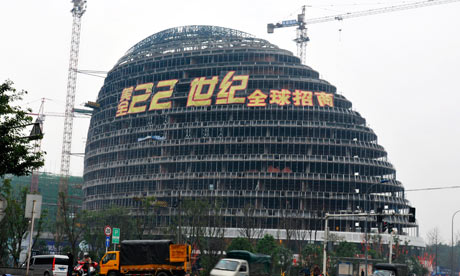
Copycat blob …The Meiquan 22nd Century building under construction in Chongqing. Photograph: Str/AFP/Getty Images
With its soaring church spire, pastel-coloured chalets and
splendid lakeside location, Hallstatt looks every inch a
picture-postcard alpine town – a place that echoes with the sound of
cowbells and yodelling, every windowbox overflowing with edelweiss. But this isn't Hallstatt in Austria. This one is in Huizhou city, in southern China.
When it was reported last year that the Austrian town had been "secretly cloned", right down to its statues of angels, some residents were outraged. But the mayor, Alexander Scheutz, was over the moon. "We are very proud," he said, as he signed up to a cultural exchange with his town's new twin. It is now clear why: the clone has been a lucrative means of cultural promotion, with the number of Chinese visitors to the real Hallstatt jumping from 50 to 1,000 per year.
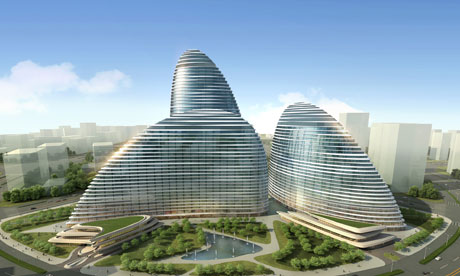
When it was reported last year that the Austrian town had been "secretly cloned", right down to its statues of angels, some residents were outraged. But the mayor, Alexander Scheutz, was over the moon. "We are very proud," he said, as he signed up to a cultural exchange with his town's new twin. It is now clear why: the clone has been a lucrative means of cultural promotion, with the number of Chinese visitors to the real Hallstatt jumping from 50 to 1,000 per year.

Zaha Hadid's Wangjing Soho building in Beijing. Courtesy of Zaha Hadid Architects
The issue of China and its attitude to intellectual property rights has now been reignited, following claims that a project in Beijing by Zaha Hadid is being replicated by "pirate architects"
in Chongqing, the megacity in the south. It could even be finished
before the original is completed next year. The British architect's
globular complex of pebble-shaped towers – an office and retail
development called Wangjing Soho – is itself something of a copy of her recently completed Galaxy Soho,
also in Beijing, and both projects are in keeping with the city's new
vernacular of bulbous UFOs, kicked off in 2007 by Paul Andreu's
National Grand Theatre.
Hadid intends to take legal action, while a furious Pan Shiyi, the billionaire chairman of the Soho empire, has vowed to "bring the infringers to court". But Chongqing Meiquan, the developer behind the building, claims innocence, insisting at a press conference that the project was inspired not by Hadid's curves but "by the cobblestones on the bank of the Yangtze river by which Chongqing was built". It also launched an advertising slogan in response to the furore: "Never meant to copy, only want to surpass."
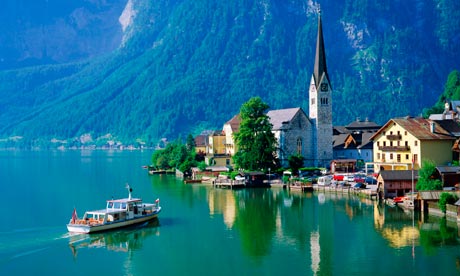 The real deal ... Hallstatt in Austria. Photograph: Robert Harding World Imagery/A/Alamy
This catchphrase could be the manifesto for modern urban China. From
pirated DVDs to knock-off designer brands, the country has a thriving
counterfeit culture, often facilitated by local protectionism and a
reluctance on the part of the authorities to enforce fledgling
intellectual property laws. Moreover, there are no specific laws
protecting architecture, due to its slippery definition as a work of
applied art – with functional and artistic qualities, in which only the
latter is protected. This overlooks the fact that the two can rarely
be separated: a facade could be an integral part of a building's
structure, as well as providing its main artistic thrust. So China, like
a global architectural magpie, helps itself to the biggest and best
bits of cities the world over.
The real deal ... Hallstatt in Austria. Photograph: Robert Harding World Imagery/A/Alamy
This catchphrase could be the manifesto for modern urban China. From
pirated DVDs to knock-off designer brands, the country has a thriving
counterfeit culture, often facilitated by local protectionism and a
reluctance on the part of the authorities to enforce fledgling
intellectual property laws. Moreover, there are no specific laws
protecting architecture, due to its slippery definition as a work of
applied art – with functional and artistic qualities, in which only the
latter is protected. This overlooks the fact that the two can rarely
be separated: a facade could be an integral part of a building's
structure, as well as providing its main artistic thrust. So China, like
a global architectural magpie, helps itself to the biggest and best
bits of cities the world over.
"Soho could have a good chance of winning litigation," You Yunting, a Shanghai-based lawyer specialising in intellectual property, told German newspaper Der Spiegel. "But even if the judge rules in favour of Soho, the court will not force the defendant to pull the building down. But it could order the payment of compensation."
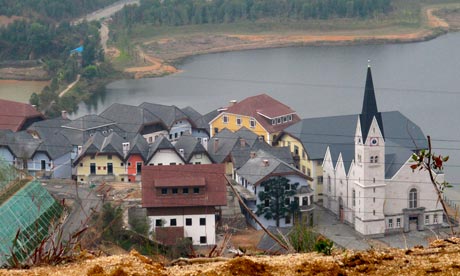 Replica of the Austrian alpine town Hallstatt in Guangdong Province, China. Photograph: Alex Hofford/Sinopix/Rex
In many copycat cases, though, the architects are either long gone or impossible to name. In Tianducheng, near Shanghai, a 108m-high Eiffel Tower rises above Champs Elysées Square;
while in Chengdu, to the south-west, a residential complex for 200,000
recreates Britain's Dorchester. The attention to detail can be
astonishing: a doppelganger Queen's Guard patrols Shanghai's Thames
Town, which abounds with statues of Winston Churchill; gleaming
replicas of the White House dot Chinese cities. It all adds up to a
surreal catalogue of "duplitecture", brilliantly documented in the
book Original Copies: Architectural Mimicry in Contemporary China by Bianca Bosker.
Replica of the Austrian alpine town Hallstatt in Guangdong Province, China. Photograph: Alex Hofford/Sinopix/Rex
In many copycat cases, though, the architects are either long gone or impossible to name. In Tianducheng, near Shanghai, a 108m-high Eiffel Tower rises above Champs Elysées Square;
while in Chengdu, to the south-west, a residential complex for 200,000
recreates Britain's Dorchester. The attention to detail can be
astonishing: a doppelganger Queen's Guard patrols Shanghai's Thames
Town, which abounds with statues of Winston Churchill; gleaming
replicas of the White House dot Chinese cities. It all adds up to a
surreal catalogue of "duplitecture", brilliantly documented in the
book Original Copies: Architectural Mimicry in Contemporary China by Bianca Bosker.
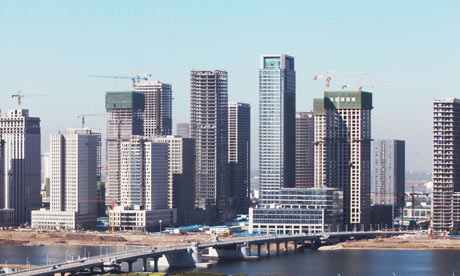 First we take Manhattan ... Tianjin's replica of New York City in China. Photograph: Getty
Not content with sampling iconic buildings, some developers are duplicating swaths of cities. In Tianjin, in northern China, a replica Manhattan is being built on the site of a 15th-century fishing village.
Complete with knock-off Rockefeller and Lincoln centres, as well as
its own Hudson river, the scheme boasts that it will be "the largest
single financial centre in the world" when it is complete in 2019.
First we take Manhattan ... Tianjin's replica of New York City in China. Photograph: Getty
Not content with sampling iconic buildings, some developers are duplicating swaths of cities. In Tianjin, in northern China, a replica Manhattan is being built on the site of a 15th-century fishing village.
Complete with knock-off Rockefeller and Lincoln centres, as well as
its own Hudson river, the scheme boasts that it will be "the largest
single financial centre in the world" when it is complete in 2019.
They say imitation is a form of flattery – but the Fondation Le Corbusier doesn't see it that way. A counterfeit version of Corbusier's Ronchamp chapel, a spellbinding building in eastern France, sprung up in Zhengzhou in the 1990s, but was demolished after the furious foundation weighed in. But all was not lost: the ruin now serves as the surreal backdrop for a restaurant.
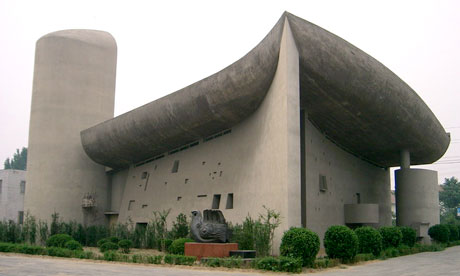 Now a barbecue restaurant ... Ronchamp in Zhengzhou, 2004. Photograph: CAIP/Blogspot
Archaeologist Jack Carlson, writing in Foreign Policy magazine,
argues that the wholesale copying of architectural culture may have its
roots in something much bigger than shameless commercial borrowing:
"The ancient parallels for these copycat projects suggest that they are
not mere follies, but monumental assertions of China's global primacy."
He cites ancient China's premier historian, Sima Qian, who recorded a
remarkable building programme pursued by China's first ruling dynasty,
the Qin: "Whenever Qin conquered one of its rivals, it would commission
replicas of its palaces and halls and reconstruct them on the slope
north of the capital. From Yongmen all the way to the Jing and Wei
rivers, there were replica palaces, passages, and walled pavilions."
Now a barbecue restaurant ... Ronchamp in Zhengzhou, 2004. Photograph: CAIP/Blogspot
Archaeologist Jack Carlson, writing in Foreign Policy magazine,
argues that the wholesale copying of architectural culture may have its
roots in something much bigger than shameless commercial borrowing:
"The ancient parallels for these copycat projects suggest that they are
not mere follies, but monumental assertions of China's global primacy."
He cites ancient China's premier historian, Sima Qian, who recorded a
remarkable building programme pursued by China's first ruling dynasty,
the Qin: "Whenever Qin conquered one of its rivals, it would commission
replicas of its palaces and halls and reconstruct them on the slope
north of the capital. From Yongmen all the way to the Jing and Wei
rivers, there were replica palaces, passages, and walled pavilions."
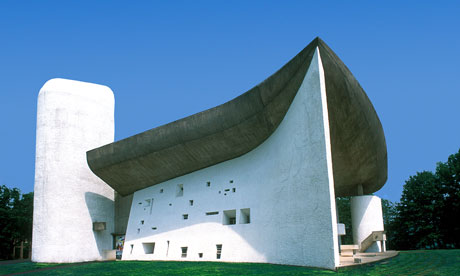
Hadid intends to take legal action, while a furious Pan Shiyi, the billionaire chairman of the Soho empire, has vowed to "bring the infringers to court". But Chongqing Meiquan, the developer behind the building, claims innocence, insisting at a press conference that the project was inspired not by Hadid's curves but "by the cobblestones on the bank of the Yangtze river by which Chongqing was built". It also launched an advertising slogan in response to the furore: "Never meant to copy, only want to surpass."
 The real deal ... Hallstatt in Austria. Photograph: Robert Harding World Imagery/A/Alamy
This catchphrase could be the manifesto for modern urban China. From
pirated DVDs to knock-off designer brands, the country has a thriving
counterfeit culture, often facilitated by local protectionism and a
reluctance on the part of the authorities to enforce fledgling
intellectual property laws. Moreover, there are no specific laws
protecting architecture, due to its slippery definition as a work of
applied art – with functional and artistic qualities, in which only the
latter is protected. This overlooks the fact that the two can rarely
be separated: a facade could be an integral part of a building's
structure, as well as providing its main artistic thrust. So China, like
a global architectural magpie, helps itself to the biggest and best
bits of cities the world over.
The real deal ... Hallstatt in Austria. Photograph: Robert Harding World Imagery/A/Alamy
This catchphrase could be the manifesto for modern urban China. From
pirated DVDs to knock-off designer brands, the country has a thriving
counterfeit culture, often facilitated by local protectionism and a
reluctance on the part of the authorities to enforce fledgling
intellectual property laws. Moreover, there are no specific laws
protecting architecture, due to its slippery definition as a work of
applied art – with functional and artistic qualities, in which only the
latter is protected. This overlooks the fact that the two can rarely
be separated: a facade could be an integral part of a building's
structure, as well as providing its main artistic thrust. So China, like
a global architectural magpie, helps itself to the biggest and best
bits of cities the world over."Soho could have a good chance of winning litigation," You Yunting, a Shanghai-based lawyer specialising in intellectual property, told German newspaper Der Spiegel. "But even if the judge rules in favour of Soho, the court will not force the defendant to pull the building down. But it could order the payment of compensation."
 Replica of the Austrian alpine town Hallstatt in Guangdong Province, China. Photograph: Alex Hofford/Sinopix/Rex
In many copycat cases, though, the architects are either long gone or impossible to name. In Tianducheng, near Shanghai, a 108m-high Eiffel Tower rises above Champs Elysées Square;
while in Chengdu, to the south-west, a residential complex for 200,000
recreates Britain's Dorchester. The attention to detail can be
astonishing: a doppelganger Queen's Guard patrols Shanghai's Thames
Town, which abounds with statues of Winston Churchill; gleaming
replicas of the White House dot Chinese cities. It all adds up to a
surreal catalogue of "duplitecture", brilliantly documented in the
book Original Copies: Architectural Mimicry in Contemporary China by Bianca Bosker.
Replica of the Austrian alpine town Hallstatt in Guangdong Province, China. Photograph: Alex Hofford/Sinopix/Rex
In many copycat cases, though, the architects are either long gone or impossible to name. In Tianducheng, near Shanghai, a 108m-high Eiffel Tower rises above Champs Elysées Square;
while in Chengdu, to the south-west, a residential complex for 200,000
recreates Britain's Dorchester. The attention to detail can be
astonishing: a doppelganger Queen's Guard patrols Shanghai's Thames
Town, which abounds with statues of Winston Churchill; gleaming
replicas of the White House dot Chinese cities. It all adds up to a
surreal catalogue of "duplitecture", brilliantly documented in the
book Original Copies: Architectural Mimicry in Contemporary China by Bianca Bosker. First we take Manhattan ... Tianjin's replica of New York City in China. Photograph: Getty
Not content with sampling iconic buildings, some developers are duplicating swaths of cities. In Tianjin, in northern China, a replica Manhattan is being built on the site of a 15th-century fishing village.
Complete with knock-off Rockefeller and Lincoln centres, as well as
its own Hudson river, the scheme boasts that it will be "the largest
single financial centre in the world" when it is complete in 2019.
First we take Manhattan ... Tianjin's replica of New York City in China. Photograph: Getty
Not content with sampling iconic buildings, some developers are duplicating swaths of cities. In Tianjin, in northern China, a replica Manhattan is being built on the site of a 15th-century fishing village.
Complete with knock-off Rockefeller and Lincoln centres, as well as
its own Hudson river, the scheme boasts that it will be "the largest
single financial centre in the world" when it is complete in 2019.They say imitation is a form of flattery – but the Fondation Le Corbusier doesn't see it that way. A counterfeit version of Corbusier's Ronchamp chapel, a spellbinding building in eastern France, sprung up in Zhengzhou in the 1990s, but was demolished after the furious foundation weighed in. But all was not lost: the ruin now serves as the surreal backdrop for a restaurant.
 Now a barbecue restaurant ... Ronchamp in Zhengzhou, 2004. Photograph: CAIP/Blogspot
Archaeologist Jack Carlson, writing in Foreign Policy magazine,
argues that the wholesale copying of architectural culture may have its
roots in something much bigger than shameless commercial borrowing:
"The ancient parallels for these copycat projects suggest that they are
not mere follies, but monumental assertions of China's global primacy."
He cites ancient China's premier historian, Sima Qian, who recorded a
remarkable building programme pursued by China's first ruling dynasty,
the Qin: "Whenever Qin conquered one of its rivals, it would commission
replicas of its palaces and halls and reconstruct them on the slope
north of the capital. From Yongmen all the way to the Jing and Wei
rivers, there were replica palaces, passages, and walled pavilions."
Now a barbecue restaurant ... Ronchamp in Zhengzhou, 2004. Photograph: CAIP/Blogspot
Archaeologist Jack Carlson, writing in Foreign Policy magazine,
argues that the wholesale copying of architectural culture may have its
roots in something much bigger than shameless commercial borrowing:
"The ancient parallels for these copycat projects suggest that they are
not mere follies, but monumental assertions of China's global primacy."
He cites ancient China's premier historian, Sima Qian, who recorded a
remarkable building programme pursued by China's first ruling dynasty,
the Qin: "Whenever Qin conquered one of its rivals, it would commission
replicas of its palaces and halls and reconstruct them on the slope
north of the capital. From Yongmen all the way to the Jing and Wei
rivers, there were replica palaces, passages, and walled pavilions."
Le Corbusier's Chapelle de Notre Dame du Haut, Ronchamp, France. Photograph: Alamy
If this clone culture does represent a kind of triumphalism – a way
for China to show it has equalled, and perhaps even transcended, the
west's achievements – should we be worried? "Architecture's whole
history is full of people copying each other," says Sam Jacob of Fat Architecture,
whose Museum of Copying was a highlight of last year's Venice Biennale;
it featured a re-make of Palladio's Villa Rotunda in spray-foam and
plaster. "It used to be thought of as a good thing. Copying antiquity is
what you were supposed to do, and new things emerged."
More recently, he says, Mies van der Rohe's reputation boomed precisely because of his ability to be copied. "That was a big part of his power and success – he could replicate himself, but other people could also replicate him easily." Jacob adds that if you look at early buildings by the architectural giant SOM (Skidmore, Owings and Merrill), they are indistinguishable from Mies; so much so, in fact, that Frank Lloyd Wright nicknamed the trio The Three Blind Mies.
Zaha Hadid's initial reaction to the doppelganger was surprisingly generous: if future generations of these cloned buildings display innovative mutations, she said, "that could be quite exciting". But at the weekend practice director Nigel Calvert said: "We will be demanding that the copycats immediately cease construction, change the exterior of the building, offer a public apology and provide compensation." Hadid added: "It is fine to take from the same well – but not from the same bucket."
More recently, he says, Mies van der Rohe's reputation boomed precisely because of his ability to be copied. "That was a big part of his power and success – he could replicate himself, but other people could also replicate him easily." Jacob adds that if you look at early buildings by the architectural giant SOM (Skidmore, Owings and Merrill), they are indistinguishable from Mies; so much so, in fact, that Frank Lloyd Wright nicknamed the trio The Three Blind Mies.
Zaha Hadid's initial reaction to the doppelganger was surprisingly generous: if future generations of these cloned buildings display innovative mutations, she said, "that could be quite exciting". But at the weekend practice director Nigel Calvert said: "We will be demanding that the copycats immediately cease construction, change the exterior of the building, offer a public apology and provide compensation." Hadid added: "It is fine to take from the same well – but not from the same bucket."

No comments:
Post a Comment
Comments always welcome!